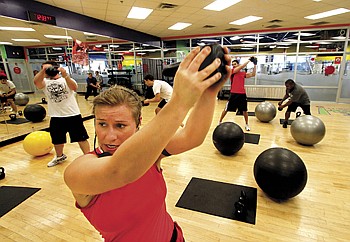For Chris Conn, the physicality of his Army training was not nearly as tough as his kettlebell workouts.
"This is 10 times harder than group exercises we did in the military," the 45-year-old University of the South philosophy professor said after producing a puddle of sweat during a kettlebell group workout at The Rush's downtown location.
Conn is one of the gym's test subjects, so to speak, as it prepares to switch its demo kettlebell classes to formal ones on Nov. 1.
The newly formed classes involve a variety of kettlebell exercises, including curls, presses, lunges, squats, rows, jumping jacks and ab exercises. They emphasize constant exertion and combinations of movements, so it's impossible to categorize the classes as either cardio-enhancing or body-building.
"The classes are for working on the muscles, as well as the lungs and the heart," said 35-year-old Rush fitness manager Emanuel Moon, who has been participating in the demo classes. "I think - or I thought - I was in magnificent shape. This lets me know I still have some way to go."
Some fitness experts say the shape of the device, which slightly resembles a tea kettle without a spout, makes it more versatile than the United States' traditional handled weight - the dumbbell.
Kettlebell terminologyGireviks - The old Russian term for a man who lifted kettlebells.Girevoy - An official kettlebell competition.Girya - The Russian word for kettlebell.Jerk - A move where a person grips the kettlebell and thrusts it overhead, locking out the elbows.Pood - A Russian word used in reference to weights used in sports, such as the traditional Russian kettlebell. A pood is approximately 16 kilograms or 36 pounds.Source: kettlebell.net
"Pretty much you can do everything that you can do with dumbbells with the kettlebells, but not vice versa," said Dmitri Sataev, a Russian immigrant who founded the United States Girevoy Sport Federation in 2003.
The roots of the word girevoy, the term for a kettlebell competition, first appeared in a Russian dictionary in 1704, according to the Dragon Door kettlebell company. Some accounts date similar devices even further back to Greece.
The ones popular in the present-day U.S. typically weigh between 10 and 100 pounds. Since The Rush puts emphases on both cardio and weight training, it uses mainly kettlebells around 40 pounds and lower. But that's not to say that even the lighter ones aren't excellent fat burners.
"You would burn more calories doing this versus a spin class - or maybe even any other class for that matter," said Jillian Ward, 25, an assistant fitness manager at The Rush who has been teaching the classes.
As Ward taught an hour-long class consisting of mostly men on Monday, she kept using phrases like "We need some more participation here" and "Don't let a girl beat you" to keep her pupils moving.
Even though Conn almost matched Ward move for move during the class, he admitted that he still has a long way to go.
"I think seeing how hard it was for me shows me there's a real opportunity for improvement," he said. "It was pushing me in a way that I'm not used to."
Scheduled kettlebell classes in October for The Rush's downtown location
10/15: 5:30-6:30 p.m.
10/18: 12:15-12:45 p.m.
10/19: 6:30-7:30 p.m.
10/22: 5:30-6:30 p.m.
10/25: 12:15-12:45 p.m.
10/26: 6:30-7:30 p.m.
10/27: 12:15-12:45 p.m.
10/29: 5:30-6:30 p.m.
